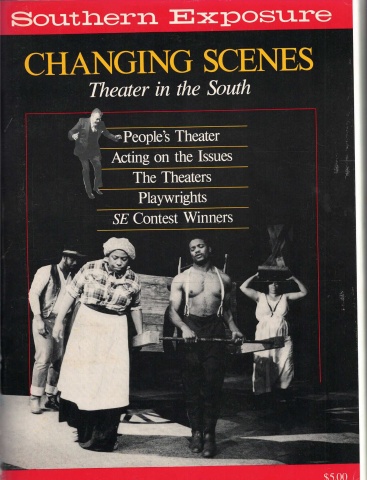The Soil of Faith

This article originally appeared in Southern Exposure Vol. 14 No. 3/4, "Changing Scenes: Theater in the South." Find more from that issue here.
My earliest recollection of religious instruction is not set in a sanctuary or classroom. Rather I remember listening, sitting in a porch swing, looking down a long hill and across Crockett’s Creek in rural Stewart County, Tennessee. My teacher was neither ordained by a church nor trained to teach Bible or theology. She was my mother’s aunt, Minerva Cherry, a woman in her 70s whom I called
“Aintie.” She told me stories and sang me songs she had never read in a book but which had been passed down to her just as she was passing them down to me.
“Aintie’s” stories formed my inner world of imagination — the soil of faith. She peopled that world with characters who told me who I was and what I valued. She told of a native of our region who was turned away from a settler’s home in a blizzard. Each time she would quote the settler’s words with the same inflection in her voice: “Be gone, you Indian dog!” But in the end, the cruel man was saved from another storm by that same “Indian dog” he had sent from his door.
She sang a song that told — in a series of questions and answers — of a son who killed his brother and fled the country, leaving a mother grieving for two lost sons. Many years later I discovered the relationship between this song and the story of another mother who lost two sons under similar circumstances: Eve in the book of Genesis.
‘‘Aintie” told her stories directly to me, and usually just the two of us were there. But there were other stories told by my mother and her sister, Maebell, that after a certain age I was allowed to overhear. These were usually family stories: of a brother and sister-in-law murdered while they slept; of Aunt Lou who had the power to stop bleeding; and of the young man whose life she saved after he fell from a pole when electricity finally came to our part of the country. These were stories of death and resurrection. They never came woven into whole cloth, but piece by piece and strand by strand I put them together in my own young imagination.
Given this oral tradition, I became fascinated by the stories of Jewish and Christian tradition. I listened intently to the preachers who told them at churches named Crockett’s Creek and Sailor’s Rest. At four I came home from church telling my parents the story of the death of a preacher named Jesus, a story they had not told me for fear of scaring a little boy.
Storytelling has been a long and honored tradition among Southern preachers, both black and white. In the past, many of these preachers could neither read nor write, but they communicated through the power of the spoken word that preceded the writing of the scriptures.
Even in this century of books, films and television, the storyteller/preacher has been a powerful figure: Clarence Jordan and his “Cottonpatch” retellings of Bible stories set in the area surrounding his home at Koinonia Farms in Georgia; Tex Evans telling of his experiences in ways that formed the imaginations of those who heard him.
Today, Fred Craddock — who grew up hearing and telling stories in West Tennessee — combines the scholarship of the seminary and the language of the front-porch teller as a preacher and teacher of preachers. Tar Heel Donald Davis tells stories to audiences across the country who might never guess that he preaches every Sunday to a congregation in High Point, North Carolina. West Virginia-born Heather Murray Elkins dances, tells her stories, and preaches, creating the worlds of the poets and prophets of ancient days for those who have ears to hear.
I mention these names to honor the tradition they bear which had its origin when all stories were of the spirit, carried on the ruah, the pneuma, the breath. We continue to tell our tales believing that, long after our names are forgotten, the stories will be remembered.
Tags
Michael Williams
Michael Williams is a storyteller and United Methodist minister in Nashville. (1986)